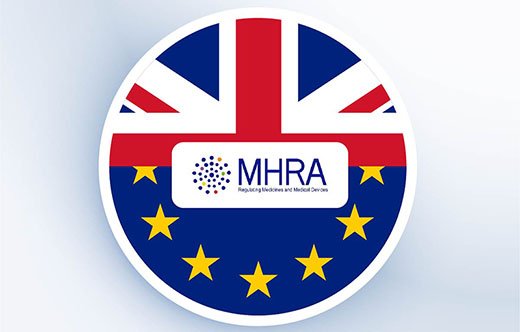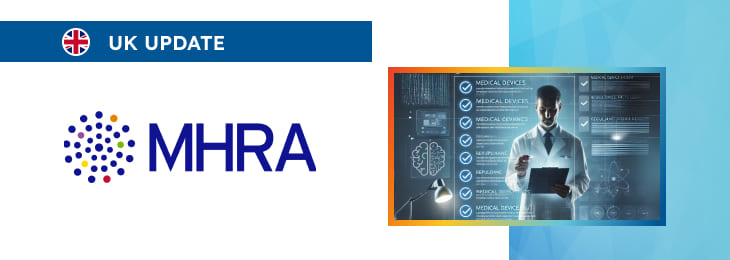The article provides an overview of the regulatory approach to be applied with respect to certain categories of innovative medical devices.

Table of content
The Medicines and Healthcare products Regulatory Agency (MHRA), the UK authority in the sphere of medical devices, has published a guidance document which describes the applicable regulatory requirements, and also provides additional clarifications and recommendations to be taken into consideration by medical device manufacturers, study sponsors, and other parties involved in the supply of medical devices intended to be marketed and used in the UK. It is important to mention that recommendations provided in the guidance could be subject to changes due to the relevant changes to the underlying legislation.
The document explains what manufacturers need to do to place a medical device on the markets of Great Britain, Northern Ireland, and the European Union (EU). It provides an overview of the UK system as managed by the Medicines and Healthcare products Regulatory Agency, outlining the key processes for device certification, conformity marking, registration, and post‑market obligations.
The guidance is tailored to medical devices – including in vitro diagnostic (IVD) devices and active implantable devices – and clarifies the differences between the regulatory frameworks that apply in Great Britain versus Northern Ireland, as well as the requirements for accessing the EU market.
Overview of the UK Regulatory System
Under the existing legal framework, the MHRA is responsible for regulating medical devices in the UK.
This guidance explains:
- Certification Process: How manufacturers can get their devices certified.
- Conformity Marking: The process for applying the appropriate conformity marks – UKCA or CE – to devices.
- Registration: The requirement to register devices with the MHRA before placing them on the market.
The document emphasizes that the guidance is for medical devices only and does not cover other products that may bear CE or UKCA markings. Manufacturers are encouraged to seek professional advice if there is any uncertainty regarding which regulatory framework applies to their goods.

Market Placement in Great Britain
Since 1 January 2021, several changes – introduced via secondary legislation – have reshaped how medical devices are placed on the Great Britain market (covering England, Wales, and Scotland).
Key elements include:
- UKCA Marking: Manufacturers now have the option of using the UK Conformity Assessed (UKCA) marking when placing devices on the Great Britain market. This marking reflects compliance with requirements that were previously based on EU directives.
- CE Marking Transitional Arrangements: The guidance outlines transitional timelines for CE‑marked devices. For instance, devices certified under the EU Medical Devices Directive (MDD) or EU Active Implantable Medical Devices Directive (AIMDD) may be placed on the Great Britain market until the certificate expires or until 30 June 2028. Similarly, in vitro diagnostic devices (IVDs) certified under the EU In Vitro Diagnostic Medical Devices Directive (IVDD) can be marketed until the certificate expires or until 30 June 2030. Devices certified under the newer EU Medical Devices Regulation (MDR) or EU In Vitro Diagnostic Regulation (IVDR) are permitted on the market until 30 June 2030.
Registration Requirements
- Every medical device – including custom-made devices, IVDs, and system or procedure packs – must be registered with the MHRA before it is marketed in Great Britain.
- For manufacturers based in the UK, registration is direct. However, those located outside the UK must appoint a single UK responsible person who will act on their behalf for registration and other specified tasks.
- A standard fee (currently set at £240 per application) applies to new registrations or changes. Failure to register means that a device cannot lawfully be placed on the market.
Role of the UK Responsible Person
The UK responsible person is a designated agent who ensures that all registration and conformity tasks are completed according to the UK Medical Devices Regulations 2002 (UK MDR 2002). This person must have the manufacturer’s authority in writing, maintain key technical documentation (including the declaration of conformity and certificates), and serve as the main liaison with the MHRA.
They are also required to communicate promptly about any complaints or incidents related to the device. It is important to mention that importers and distributors do not have to appoint a UK responsible person unless they are fulfilling that role for the purposes of registration and conformity marking.
Legislation Governing Devices in Great Britain
The regulatory framework in Great Britain is derived from the UK MDR 2002, which was originally enacted to implement EU directives such as:
- Directive 90/385/EEC (active implantable medical devices),
- Directive 93/42/EEC (medical devices), and
- Directive 98/79/EC (in vitro diagnostic devices).
These directives laid the groundwork for the current UK system. With the UK’s departure from the EU, the UK MDR 2002 continues to serve as the basis for conformity assessment and market placement. In parallel, the government has enacted measures to extend the acceptance of CE‑marked devices beyond 30 June 2023, providing a transitional period during which both UKCA‑ and CE‑marked devices can be marketed in Great Britain.
The EU Regulations and Their Application
Although the UK has its own system, the guidance also addresses devices placed on the EU market, explaining the applicability of the EU Medical Devices Regulation (MDR) and EU In Vitro Diagnostic Regulation (IVDR). The EU MDR (effective 26 May 2021) and EU IVDR (effective 26 May 2022) now apply to EU Member States and Northern Ireland.
These regulations are not automatically retained in Great Britain. However, transitional arrangements allow devices that have been CE‑marked under these regulations to be accepted on the Great Britain market until the prescribed deadlines (up to 2030 in some cases). The EU notified bodies are essential for mandatory third‑party conformity assessments required for CE marking. UK notified bodies have been re-designated as UK approved bodies and no longer issue CE certificates.
Placing Devices on the EU Market
In this respect, the authority highlights a few key points to be taken into consideration:
- CE Marking: The UKCA marking is not accepted in the EU. Therefore, to supply devices to the EU, manufacturers must comply with EU requirements and affix a CE mark.
- Authorised Representatives: Great Britain-based authorised representatives are no longer recognised in the EU. Manufacturers must appoint an EU-based or Northern Ireland‑based authorised representative if they wish to place their devices on the EU market.
Conformity Assessment and Product Marking
A key part of market placement is the conformity assessment and appropriate marking of medical devices. The UKCA marking is a conformity mark used for devices on the Great Britain market.
It demonstrates compliance with the UK’s specific regulatory requirements. When third‑party conformity assessment is needed, manufacturers must use a UK approved body.
For non‑sterile, non‑measuring Class I devices and general IVDs, self‑certification is possible. Devices may carry both UKCA and CE markings provided that both sets of requirements are met.
When dual marking is used, the details of the UK responsible person must appear on the label if the UKCA mark is affixed.
Marking and Transitional Arrangements
CE‑marked devices will be accepted on the Great Britain market until a specific deadline (up to 30 June 2030 for many devices), subject to the type of device and whether it conforms to the appropriate EU legislation. Manufacturers of certain Class I devices and general IVDs may self‑declare conformity with EU requirements.
However, for devices that require third‑party assessment, such as those involving sterile or measuring functions, a notified body must be involved. The guidance details different timelines based on the device type – for instance, general medical devices under the EU MDD or AIMDD have a different timeline than those under the newer EU MDR or IVDR.
This phased approach facilitates a smoother transition for manufacturers.
UK Approved Bodies and Notified Bodies
For devices using the UKCA marking, conformity assessments can be carried out by UK approved bodies. These bodies were formerly UK notified bodies before re-designation. For CE‑marked devices, the conformity assessment must be carried out by an EU‑recognised notified body.
Certificates issued by EU‑based notified bodies remain valid for devices on the Great Britain market under the transitional arrangements.
Registration and Labelling Requirements
Registration with the MHRA is a critical step before any device can be placed on the Great Britain market. All medical devices – including IVDs, custom‑made devices, and procedure packs – must be registered.
For manufacturers based outside the UK, a UK responsible person must be appointed to register the device. A standard fee is charged per application, and the manufacturer (or UK responsible person) must provide all relevant technical documentation, declarations of conformity, and certificates.
Any new registration or changes to an existing registration incur this fee. Without registration, devices cannot be lawfully placed on the market, making strict adherence to these requirements essential.
Devices on the Great Britain market must display either the UKCA or the CE marking, depending on the certification pathway. When applicable, the approved body’s or notified body’s number must be included on the label.
If a UK responsible person is appointed (for non‑UK manufacturers), their name and address must appear on the product labelling, the outer packaging, or the instructions for use – this is required when the UKCA marking is used. Devices bearing both the UKCA and CE marks must ensure that neither mark impedes the visibility of the other.
However, for CE‑marked devices that do not display UKCA, the details of the UK responsible person are not required on the label.
Special Considerations for Northern Ireland
The regulatory framework for medical devices in Northern Ireland is distinct due to the Northern Ireland Protocol.
The guidance outlines several key points for devices placed on the Northern Ireland market:
- EU MDR and EU IVDR: In Northern Ireland, the EU Medical Devices Regulation (MDR) and the EU In Vitro Diagnostic Regulation (IVDR) have been in force since 26 May 2021 and 26 May 2022, respectively. Consequently, CE marking is mandatory.
- Registration Requirements: Certain medical devices, including custom‑made devices, must be registered with the MHRA within 28 days of being made available on the market.
- Authorised Representatives: Great Britain‑based manufacturers must appoint an EU‑ or Northern Ireland‑based authorised representative to supply devices in Northern Ireland.
- UKNI Indication: For devices that undergo mandatory third‑party conformity assessment via a UK notified body, an additional UKNI (UK (Northern Ireland)) marking must accompany the CE mark. However, if self‑certification is used or if an EU‑recognised notified body is involved, the UKNI indication is not required.
- Dual Market Access: Provided that a device is CE marked and qualifies as a “Northern Ireland good”, it can be placed on both the Northern Ireland and Great Britain markets without additional registration for Great Britain.
Post‑Market Surveillance and Vigilance
After a medical device is placed on the market, ongoing monitoring and vigilance are crucial for ensuring continued safety and performance. Manufacturers must report any incidents or adverse events related to their device to the MHRA.
This requirement is fundamental to ensuring that any safety issues are swiftly addressed. New legislation introduced in 2024 strengthens post‑market surveillance requirements in Great Britain.
These measures, coming into force on 16 June 2025, will improve incident traceability and support rapid regulatory action to mitigate risks. Manufacturers are responsible for taking appropriate corrective measures should any issues arise during the device’s lifecycle.
Manufacturers must also maintain updated technical documentation and communicate with the MHRA as needed to demonstrate that their devices continue to meet the required standards of safety and performance.
Placing Devices on the EU Market
For manufacturers targeting the EU market, the guidance specifies that:
- The UKCA marking is not recognised in the EU. Therefore, compliance with EU regulations and the application of the CE mark are mandatory.
- Any mandatory conformity assessments for CE marking must be performed by an EU‑recognised notified body. The results from UK‑based assessments are not accepted by the EU.
- Manufacturers based in Great Britain or non‑EU countries must appoint an authorised representative located within the EU or Northern Ireland to act on their behalf.
Additionally, the guidance clarifies that while a device may carry both UKCA and CE markings, the two marks serve different regulatory purposes and must be used in accordance with the market into which the device is being placed.
Conclusion
In summary, this guidance on regulating medical devices in the UK provides manufacturers with a detailed roadmap for achieving compliance across multiple markets:
- For the Great Britain Market: Manufacturers must navigate new routes to market, which include using the UKCA marking, registering devices with the MHRA, and appointing a UK responsible person if they are not based in the UK. The transitional acceptance of CE‑marked devices ensures that devices certified under previous EU directives may continue to be marketed until specific deadlines.
- For Northern Ireland: The regulatory framework aligns with EU legislation (EU MDR and EU IVDR), requiring CE marking and, in certain cases, the additional UKNI indication. Registration, appointing authorised representatives, and meeting specific labelling requirements are all essential.
- For the EU Market: The CE marking remains the key conformity mark, with the necessity of using EU‑recognised notified bodies for third‑party conformity assessments. UK‑based authorized representatives are no longer accepted for EU market placements.
The rigorous regulatory requirements outlined here above are intended to ensure any and all medical devices allowed for marketing and use are fully compliant with the relevant safety and performance standards based on their intended use.
How Can RegDesk Help?
RegDesk is an AI-powered Regulatory Information Management System that provides medical device companies with regulatory intelligence for over 120 markets worldwide. It can help you prepare and publish global applications, manage standards, run change assessments, and obtain real-time alerts on regulatory changes through a centralized platform. Global expansion has never been this simple.

